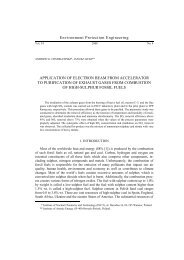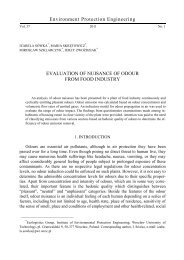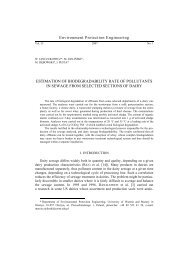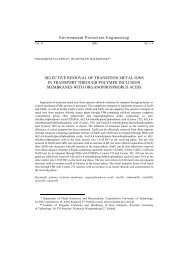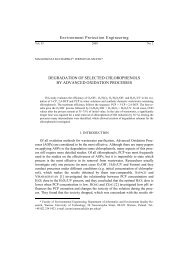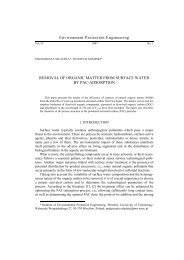Removal of pertechnetate ion from radioactive waste using anion ...
Removal of pertechnetate ion from radioactive waste using anion ...
Removal of pertechnetate ion from radioactive waste using anion ...
You also want an ePaper? Increase the reach of your titles
YUMPU automatically turns print PDFs into web optimized ePapers that Google loves.
120<br />
H. INOUE et al.<br />
laws; nevertheless, 99m Tc excreted by patients injected with nuclear medicines has<br />
been detected in sludge and in supernatant liquid <strong>from</strong> processing pool in the Kurume<br />
Central Sewage Treatment Plant in Japan [1]. When technetium is released to the envi-<br />
−<br />
ronment, <strong>pertechnetate</strong> <strong>ion</strong> ( TcO4<br />
), the main chemical form <strong>of</strong> technetium, may be<br />
readily absorbed in the human body through agricultural products.<br />
We have already developed the method for concentrating the <strong>waste</strong> containing <strong>radioactive</strong><br />
iodine by means <strong>of</strong> an an<strong>ion</strong>-exchange paper membrane. The process has<br />
a compact apparatus design with no large reservoir [2], and the used paper membrane<br />
can be safely incinerated. We have also shown that removal <strong>of</strong> <strong>radioactive</strong> iodine <strong>from</strong><br />
<strong>waste</strong> <strong>using</strong> an an<strong>ion</strong>-exchange paper membrane is not influenced by electroneutral<br />
substances such as glucose or urea [3]. It has been found that the introduct<strong>ion</strong> <strong>of</strong><br />
trimethylhydroxypropylammonium group into the cellulose fibers improves <strong>radioactive</strong><br />
iodine diffus<strong>ion</strong> within the paper membrane and that the introduct<strong>ion</strong> <strong>of</strong> quaternary<br />
diethylaminoethyl groups improves the <strong>radioactive</strong> iodine solut<strong>ion</strong>/membrane<br />
distribut<strong>ion</strong> process [4]. In addit<strong>ion</strong>, the ratio <strong>of</strong> the electroconductive membrane permeability<br />
to <strong>radioactive</strong> iodine to that to <strong>radioactive</strong> chloride has been shown to be as<br />
high as 6.2 for an an<strong>ion</strong>-exchange paper membrane containing trimethylhydroxypropylammonium<br />
groups [5].<br />
In the present study, we systematically analyze the flux and the behaviour <strong>of</strong><br />
membrane-phase pertechnate <strong>ion</strong>s occurring in trace amounts in the condit<strong>ion</strong>s <strong>of</strong> large<br />
amounts <strong>of</strong> chloride <strong>ion</strong>s (present in actual <strong>radioactive</strong> <strong>waste</strong>) <strong>using</strong> the an<strong>ion</strong>exchange<br />
paper membrane method. The results were compared with those for an an<strong>ion</strong>-exchange<br />
polymer membrane. Membrane transport analyses were carried out <strong>using</strong><br />
the linear phenomenological equat<strong>ion</strong>s being based on nonequilibrium thermodynamics.<br />
2. METHODS<br />
Introduct<strong>ion</strong> <strong>of</strong> trimethylhydroxypropylammonium an<strong>ion</strong>-exchange groups into cellulose<br />
fiber was carried out according to methods previously described [4], [5]. At first,<br />
the prepared cellulose fiber was refined to make their surfaces rough for better bonding.<br />
The paper membrane was then formed <strong>from</strong> a diluted fiber slurry, allowing the water to<br />
drain through a nylon net (100 mesh). The paper membrane was placed between unwoven<br />
clothes and pressed with a heated rolling pin to remove surplus water. Remaining<br />
free water was liberated by heating the membrane on a hot plate at 60 °C. The <strong>ion</strong>exchange<br />
capacity <strong>of</strong> the prepared paper membrane was measured by standard methods.<br />
A univalent selective an<strong>ion</strong>-exchange polymer membrane, NEOSEPTA® AM-1, donated<br />
by Astom Corporat<strong>ion</strong>, Japan, was used in the present study as a reference membrane.<br />
The table summarizes the thickness, the <strong>ion</strong>-exchange capacities, and the water<br />
contents in the paper membrane and the polymer membrane.



